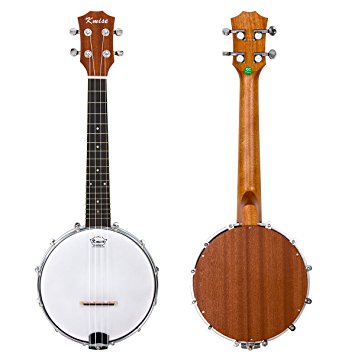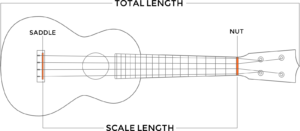
Banjolele Tuning is very simple, and is basically the same as tuning a Ukulele. You simply need to figure out the size of your Banjolele to figure out how it should be tuned. Easy Peesy Lemon Squeezy.
Also, If you’re interested in getting a clip on tuner……check out the Peterson StroboClip tuner (link to amazon). The most accurate tuner I’ve ever used.
Table of Contents:
- How Do I Determine the size Banjolele I have?
- Now you know what size your Banjolele is, how do I tune it?
- Some situations where you might consider tuning it differently
- Conclusion
How Do I Determine the size Banjolele I have?
Determining the size of your Banjolele is easy.
There are four different sizes of Banjolele just like there are four different sizes of Ukulele (makes sense since a Banjolele is just the baby of a Ukulele and a Banjo)
Before you go stickler on me though, yes there is a fifth size of Ukulele and that is the Sopranissimo. It’s not a normal style (even though it is gaining popularity) and as far as I have seen there aren’t any Banjoleles that are sopranissimo sized.
The way to tell the size of your Banjolele is to measure from the nut to the saddle of the instrument.
(Nut and Bridge diagram for anyone that doesn’t understand)
Image Cred: BeginnerUkuleles

Hopefully you have measuring tape nearby, I always seem to lose mine.
You won’t be able to measure with a ruler, it will be to small.
- Soprano – 13″ (33cm)
- Concert (Also called Alto) – 15″ (38 cm)
- Tenor – 17″ (43 cm)
- Baritone – 19″ (48 cm)
Note: If you have an older Ukulele anywhere from the 70s and earlier sometimes you’ll find one that is not any of the sizes mentioned or is simply off just a tad. Don’t worry, everything is fine you’ll still be able to tune your Banjolele. A lot of the earlier models of these instruments were having adjustments and lots of experimenting was going on since Banjoleles had only recently come out and Ukuleles even were only not to long before coming out with different sizes other than the original Soprano.
Now You Know what size your Banjolele is, How do I tune it?
Tuning a Banjolele is a simple process and it is almost exactly the same as it would be on any instrument, it simply comes down to what tuning you need for your Banjolele and then tuning it just as you would a guitar or Ukulele.
I know for some this seems obvious, but for those that don’t know how here’s a quick video of how to tune up a Ukulele. The process is the exact same on the Banjolele.
If this seems frustrating, don’t worry it might take a few minutes to get it at first but after a few tries you’ll be able to tune in no time. It does take a little bit of time to develop the ear to hear when something is exactly on pitch, and if you’re really struggling there are plenty of electronic tuners out there that can help.
Also, if your Banjolele has older strings or recently has new ones put on you may notice the strings slipping a little bit and falling out of tune right after or not long after you’ve just tuned it. Don’t worry, you can simply either replace the strings or just keep tuning it if you have new ones put on. It takes a little bit for strings to stretch out and get “comfortable” with the instrument.
How to Tune a Soprano –
The Soprano Banjolele is my favorite sounding Banjolele. I really like a high pitched twang sound.
Tuning it? So easy. The tuning is GCEA. Starting with the bottom string (The string closest to you) as G and ending with the highest as A.
How To Tune a Concert –
More than Likely, this is the size Banjolele you have. Almost all seem to have been made in this size, and I’m pretty sure that’s because that’s the size George Formby played (Who made the Banjolele popular).
Very rarely are these made in other sizes, however there are some. If you’ve got a Concert Banjolele you’ll want to tune it GCEA just like the Soprano, no changes. GCEA.
How To Tune a Tenor –
Some slight differences with the Tenor.
So far, all the Banjoleles are tuned GCEA, with the Tenor Banjolele there is also DGBE. Both of these tunings work similarly and it’s up to your personal preference which one you choose.
How To Tune a Baritone –
This is the only Banjolele size that GCEA is not a very good option. With the Baritone Banjolele you’ll want to tune either DGBE or CGBE.
These tunings are the same as the top four strings of a guitar, so for all you guitar players out there this will feel extremely familiar and will help you get comfortable fairly quickly.
Fun Fact: There are many people out there who think these Baritone instruments should have never been classified as Ukuleles and should’ve just been considered a smaller type of guitar……so would that make a Baritone Banjolele a Banjotar? Food for thought.
Situations Where you Might Want to consider Tuning it Differently:
As you can tell, the Banjolele is basically tuned like Ukuleles…..and so if you want to have some fun maybe try some of these tunings to. Just to spice things up.
Slack Key Tuning :
Made popular in Hawaiian music after men from Spain brought their Guitars over and Hawaiian natives learned to play. During this time they changed the tuning and were actually spending most of their time herding cows because currently it was illegal to kill them and they were roaming everywhere.
Back on topic though…
This tuning sounds phenomenal played on almost any instrument and will put you in a trance. The people of Hawaii love it because it captures what their culture is all about. Playing this tuning on a Banjolele could be super fun and rewarding. I’m probably going to try this soon actually.
English Tuning :
Also known as D tuning (not drop D if there are any metalheads reading this), English Tuning is just a very very rich sounding tuning that is slightly higher than regular tuning. Just take your GCEA and bring it a whole step up. People usually use this tuning on Soprano instruments. If you’re interested in how it sounds, simply place a capo at the second fret since it’s technically the same thing.
Conclusion:
Tuning a Banjolele is virtually the same as tuning a Ukulele, just important to know which tunings work for what size. Mess around with it though, I’ve personally tuned mine just like the end of a guitar (DGBE) and I have a Concert so that’s technically not a correct tuning but I think it sounds awesome and I’d recommend trying it. (Don’t blame me though if you break a string going back and forth tunings though).
Also, like I said before definitely check what size your Banjolele is if it’s an older model. Some of the “Concert” Banjolele were closer to Tenor size and really back then the sizes were all a tad bit iffy (Really not to big a deal though).
Leave a comment if I missed anything, thanks so much for reading.
